The quality of drinking water is decreasing in distinct parts of the globe. Among the major sources of aquatic environmental pollution we have tannery wastewaters (TW). Pharmaceuticals into waters are reported as emerging pollutants and both of them are also related to surfactants and dyes usage during the manufacture. TW was the worst in terms of toxicity and organic matter, referred as chemical oxygen demand, when compared to surfactants, textile and pharmaceuticals considered in the present study. From the five surfactants alkylene oxide was relatively more toxic than the others to dafnids. The intention of the selected results, figures and discussion was to highlight so wide types and ways for water contamination as well as to demonstrate health and ecological risks related to effluent emissions by different productive sectors. When excessive amount of pollutants are introduced into the rivers they may reduce their biodegradation dynamics, reducing aquatic life diversity and relevant ecological services. Some important contributions to improve effluents control and treatment have also been discussed.
Wastewater loadings have constantly been diluted in watershed all around the world, dis-considering the needs for safe drinking water for a growing global population and the ecological risks which they imply for decreasing living organisms species and ecosystem services. Scientists efforts have demonstrated the relationship between pollutants and human health for many years. During the last decade, the negative effects of emerging organic pollutants have been extensively discussed, with emphasis for pharmaceutical residues into environmental matrices [1,2].
Although some authors include microbial among the organic emerging pollutants, most of them refer only to chemicals. Emerging pollutants may be defined as synthetic or naturally occurring chemicals that are not commonly monitored in the environment but which have the potential to enter the environment and cause known or suspected adverse ecological and human health effects [1,3,4].
Regarding human needs of drinking water, the numbers are quite different even at one given country. The global population is higher than 7.5 billion people, while in Brazil we reach approximately 209.229.469 [5,6]. Major sector for water consumption in Brazil is agriculture (>50%) and according to FAO, agriculture, and especially irrigated agriculture is the sector with by far the largest consumptive water use and water withdrawal [7].
The objective of this paper was to highlight the environmental risks of three main type of effluents and their relationship with toxic charges that are received by aquatic systems. This group consists of the tannery, textile and pharmaceutical wastewaters, including chemical surfactants. Whole toxicity results were compared.
Tannery industries are listed as the most polluting activity due to the wide type of chemicals applied during the conversion of animal skins into leather. Chromium salts, phenolics, tannins, organic matter, among others products, are constantly released to the environment in tannery wastewater. These pollutants offer environmental risks to the aquatic life and human health [2]. In China high concentration of NH4-N and Ge were listed as impact and residues for the local ecosystem and human health [8]. Pathogenic and non-pathogenic bacteria are part of the organic matter in effluents (coliforms, anaerobic spore-forming bacilli. Streptococci, Staphylococci, etc) [9].
How leather is slowly killing the people and places that make it? It was written by [10]. In India there are more than 3,000 tanneries, and most of them (nearly 80%) are produced in chrome tanning process [11]. Health risks related to this manufacture was shown at Figure 1 and they were discussed by different authors. Brazil is also an important exporter of blue-leather tanning. Many efforts from different countries have been made for diminishing ecological and human health risks once this activity is very important for the economy and positive impacts of the good initiatives were presented during the discussion section [12-14].
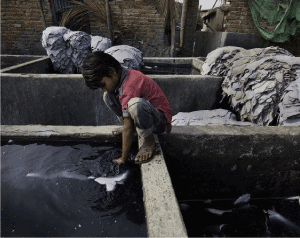
Figure 1. Health risks of pollutants related to tannery industry (chemical and microbial contaminants)
Surfactants are one of the most common components used in detergents and softeners, comprising 15% to 40% of the total formulation. In the United States, for example, surfactants are generally listed as an ingredient contained in 117 cleansers in general, 68 in care products, and 103 in the laundry [15]. The per capita detergent consumption can reach up to 10kg by year depending on the location, as it is illustrated in the case of the United States [16].
In relation to the negative effects of surfactants on biota, some citations included: gradual destructuring of membrane systems, with interference in the energy metabolism and transport of nutrients and oxygen in different organisms; weakening of structures for organisms protection and various physiological changes; photosynthetic and chlorophyll rate reduction in vegetables, deleterious effects on several species of bacteria [16,17].
Textile effluents are critical because they have several contaminants, such as surfactants, dyestuffs, peroxides, salts, acids, which are toxic to aquatic fauna and flora and may contribute to important water quality parameters changes. Another critical aspect is the residual color in wastewaters. Some estimations show that up to 30% of dyestuffs used in fiber dyeing will make up the final effluent [18], although these numbers vary according to different factors.
Among ecological effects related to dyes and textile effluents there are: induction of genotoxicity besides enzymatic changes and oxidative stress (Danio rerio, fish); high mucus secretion (Gambusia affinis) [19-21] mutagenicity - Salmonella bacteria test [22] acute and chronic toxicity to different organisms [4,23] in rats and mice, it has also been reported negative effects in the reproductive and hematopoietic systems, and histopathological lesions in heart and lungs [12,24].
Increased consumption of pharmaceutical has led to the identification of human and veterinary pharmaceuticals as emerging contaminants in the environment [25]. Sewage is the main rote of pharmaceuticals into the aquatic ecosystems (also veterinarian medicines, agriculture, and industry) [26]. Pharmaceuticals are continuously discharged but not always efficiently removed, so most of them persist in the environment [27]. After ingestion, they are excreted in biologically active form, as residues or active metabolite [28]. Mainly because of the incomplete degradation at wastewater plants, pharmaceutical residues and metabolites occur in rivers, lakes, and waters, groundwater, and also in drinking water [29,30].
Steroidal estrogens have become an emerging and serious concern. Worldwide, including estrone, estradiol, and estriol. They pose serious threats to soil, plants, water resources, and humans. Environmental concentrations of pharmaceuticals have been reported in the range of 10-1000 ng.L-1 [26]. The risks associated with pharmaceuticals are of chronic character once they are designed to trigger specific biological responses to living organisms and therefore can cause lethal effects even at low concentrations [31]. Aquatic organisms are invariably exposed to mixtures of contaminants and individual components may interact, producing synergistic effects or toxic effects [32]. The combined joint effects of blends should be considered and chemical risks for aquatic life have to deal with this complex exposure situation. Consequences of environmental pharmaceutical mixtures are identified as one of the top priority research needs to understand the risks represented by long-term exposure to pharmaceuticals [1,3]. Data on the main pharmaceuticals marked in Brazil in 2017, are shown in Table 1.
Development toxicity tests are designed to detect xenobiotic agents that affect embryonic development. Embryonic development can be considered a “weak link” in the life cycle of an organism [34] See Figure 2.
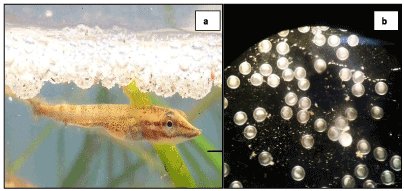
Figure 2. Pollutants negative impacts to aquatic life. a) Fish under a layer of microplastics and diverse pollutants; b) Embryo fish assays for measuring the toxic effects of pollutants that kill fish embryos
Table 1.Diversity and commercialization of some type of pharmaceuticals in Brazil (2017), according National Agency of Sanitary Surveillance (Anvisa) [33], with adaptations
Application
|
Classes of Pharmaceuticals
|
packaging (millions)
|
Cardiovascular diseases
|
Antiarrhythmics; Vasodilators, Cardioglicosides and Diuretics.
|
694
|
Antidepressants
|
Selective Reuptake Inhibitors: Serotonin, Noradrenaline, Dopamine; Tricyclic and
Tetracyclic; Monoamine oxidase inhibitors.
|
650
|
Digestive system and metabolism
|
Antacids, Digestive and Gastric.
|
603
|
Respiratory system
diseases
|
Nasal decongestant.
|
436
|
Hormonal Contraceptives
|
Ethinylestradiol, Levonorgestrel, Drospirenone and
Cyproterone Acetate.
|
336
|
Antibiotics
|
Aminoglycosides; Cephalosporins, Macrolides,
Penicillins, Quinolones, Sulphonamides and Tetracyclines.
|
305
|
Antiinflammatory
Analgesics
|
Diclofenac, Dipyrone, Ibuprofen,
Nimesulide and Paracetamol.
|
200
|
Dermatologists
|
Creams, Lotions, Shampoos,
Body Moisturizers, Sunscreens.
|
175
|
Cancer
|
Approximately 50 cancer Pharmaceuticals are considered Essential by the World Health
Organization.
|
41
|
The paper was based on the literature using a distinct database. The practical obtained data was carried out at Biological Environment Assays Laboratory (LEBA- IPEN/SP), in Brazil. Results were obtained during the last four years. This laboratory is in charge of ecotoxicity assays specially applied for effluents and durty samples.
Samplings
Two sampling of tannery influent and effluent were carried out and exposed to aquatic organisms (acute effects). Five types of surfactants were assessed for toxicity in aqueous solutions (anionic and non-ionic) and they are the main surfactants used for textile dyeing. On the other hand, three sampling of red stantard textile effluent (Reactive Red 239) were included. Acute toxicity of pharmaceuticals was measured with commercial products. In this particular case, the toxicity evaluations were carried out in aqueous solutions.
Toxicity data were expressed as EC50 numbers (median effective concentration) is the concentration of a chemical estimated to produce a specific effect in 50% of a population of test species after a specified lenght of exposure (24 or 48h). Typical effect criteria include immobility, a developmental abnormality or deformity, loss of equilibrium, failure to respond to an external stimulus, and abnormal behavior [34].
At least two biological organisms were exposed to each pollutant and three measurements were conducted. Average results from three measurements were presented for Daphnia similis and Vibrio fischeri (Figure 3). These assays were carried out according to standardized procedures [35,36]. The last assay was conducted at a Microbics Analyser, based on decreasing luminecesce of V. fischeri bactéria.
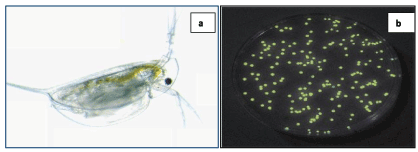
Figure 3. Exposed test-organims: a) Daphnia similis. b) Vibrio fischeri
In relation to the toxicity of contaminants, the concentration-response relationship is a graded relationship between the concentration of the test chemical to which the organisms are exposed and the severity of the response elicited (Figure 4). Generally, the greater the exposure concentration of the test chemical, more severe is the lethality (or other biological indication of effects) [34].
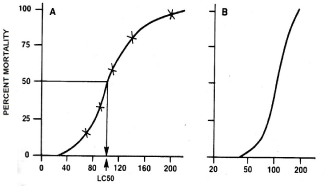
Figure 4. Percent mortality versus concentration (response curve). Source: Rand, 1995 [34]
Referring to tannery wastes and wastewater, the results were presented in the following order: a load of tannery effluents (data from this paper) and quantity of solid waste, as an example, and according to [13], (Table 2) (Table 3). Toxicity data from the given examples were compared at Table 4, and included the three type of samples. Whole toxicity of five surfactants were compared at Figure 5. Textile effluents data was included in Table 4. Data obtained for pharmaceuticals were listed at Table 5. Fluoxetine hidrochloride, active substance of Prozac antidepressure product, was more toxic than the other and it is a low biodegradability chemical [37].
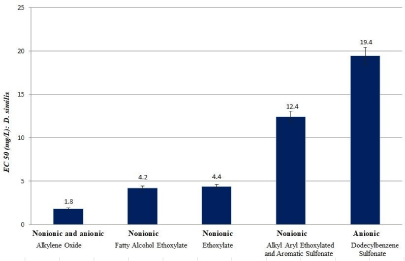
Figure 5. Acute toxicity to D. similis exposed to different surfactants, commonly applied during textile processing
Table 2. Tannery effluent: organic matter and whole acute toxicity
BOD*/COD** Biological and chemical oxygen demand; EC50 – Average effective concentration for D.similis exposures for 48 hours
Description
|
BOD and COD
(mg.L-1)
|
Toxicity – EC50
(%, v/v)
|
Raw Effluent
|
4.140*
9.700**
|
1.44 ± 0.21
|
Conventional Treatment
Effluent
|
820*
1.380**
|
13.44 ± 2.13
|
Table 3. Main constituints of solids residues from tannery manufacture. Source: Saxena et al., 2015 [13]
Natural os solid waste generated
|
Quantity (kg)
|
Salt from handshaking
|
80
|
Salt from solar pans (not realized)
|
220
|
Hair (pasting ovine)
|
100
|
Raw trimmings
|
40
|
Lime sludge (mostly bovine)
|
60
|
Fleshing
|
120
|
Wet blue trimmings (grains splits)
|
30
|
Chrome splitting (bovine)
|
65
|
Chrome shaving (mostly bovine)
|
95
|
Buffinf dust (incluing shaving bovine after crust)
|
65
|
Dyed trimmings
|
35
|
Dry sludge from Common effluent treatment plant
|
125
|
Table 4. EC50 values obtained for all samples which are used for the toxic charge determination
Samples
|
Organisms-test
|
EC 50(%)
|
TU
|
Pharmaceuticals
|
Propanolol
|
V. fischeri *
D.similis**
|
55.20
7.45
|
1.81
13.42
|
Fluoxetine
|
D.similis **
|
12.58
|
7.94
|
FLX+ PRP
|
V. fischeri* D.similis **
|
45.65
9.38
|
2.19
10.66
|
Surfactants
|
Nonionic
|
D.similis**
|
0.42 -1.24
|
80.64 - 238.09
|
Anionic
|
D.similis**
|
1.94
|
51.54
|
Textille
|
V. fischeri *
D.similis**
|
8.40
6.75
|
11.90
14.81
|
Tannery
|
D.similis**
|
1.44
|
69.4
|
Legend: * 15 min.; ** 48 h; FLX= Fluoxetine; PRP = Propanolol; TU= Toxicity Units; EC 50= median effective concentration
Table 5. Few examples of toxicity of pharmaceuticals and mixtures for water flea and bacteria
Pharmaceuticals
|
Organism-test
|
EC 50 (mg.L-1)
|
Reference
|
Fluoxetine
|
V. fischeri *
D.similis**
|
5.89
12.80
|
[37]
|
Diclofenac
|
V. fischeri *
D.similis **
|
5.12
24.86
|
[40]
|
Propranolol
|
V. fischeri *
D.similis**
|
55.20
7.45
|
Present study
|
FLX + PRP
|
V. fischeri* D.similis**
|
45.65
9.38
|
Present study
|
FLX + DIC
|
V. fischeri*
D.similis**
|
14.95
24.23
|
[40]
|
Legend: * 15 min.; ** 48 h; FLX= Fluoxetine; PRP = Propanolol; DIC= Diclofenac; EC 50= median effective concentration
Tannery wastewater was presented as an example of environmental risks and the needs for improving all the manufacture processing. According to Table 3 more than 100 kg of chrome may enter the environment through the deposition of the solid sludge, among salts and a wide list of chemicals [13].
From the five surfactants, alquilene oxide as the more toxic than the others with EC50 ranged from 1.8 mg/L (Nonionic and Anionic - alkylene oxide) to 19.4 mg/L (Anionic - Dodecylbenzene Sulfonate), demonstrating the high toxicity of these compounds to the exposed organism (Figure 5). Important is to highlight that surfactants are applied during most of producing sector, which include tannery, pharmaceuticals, food and others. [38] demonstrated values of EC 50 for D. magna of 29.87 mg/L and V. fischeri of 32.71 mg/L (anionic surfactant). In this study, EC50 of the anionic surfactant dodecylbenzene sulfonate was 19.4 mg/L (D. similis). For non- ionic surfactants, EC 50(mg/L) values for V.fischeri of 0.35 and for D.magna of 6.8 are reported by [39]. In this study, for D. similis, the EC50 (mg/L) of these surfactants was between 4.2 and 12.4.
In the present study, the organisms Daphnia similis (crustacean) and Vibrio fischeri (bacteria) were exposed to a textile effluent with dye reactive Red 239 for evaluation of acute toxicity (Table 4). The values expressed by EC 50(%) showed high toxicity of effluent for the two organisms: EC 50(%) 6.75 (D. similis) and 8.40 (V. fischeri). Different toxicity studies also revealed the high toxicity of textile effluents, with values of EC 50(%) between 1.40 and 28.1 for C. sativus, D. similis, D. subspicatus, V. fischeri, among others organisms [4,23,41].
As a general discussion and comparisons we consider the tannery effluent as the worst example, during this projet. Although tannery activities are crucial for east asian countries economy, the environmental and health pollution aspects have to be given a due consideration. Due to leather exporting ammount from Bangladesh, some Hazaribagh neighborhood is hated as one of the five most toxic, heavily-polluted sites on the entire planet [42]. Back in 1981, a study carried out by the International Agency for Research on Cancer (IARC) found no link between the tanning process and nasal cancer in tannery workers. However, over the next few years, additional case reports and studies began uncovering a link not just to nasal cancer but bladder and testicular cancer as well, which was associated with the dyes or solvents employed in the finishing process. By the mid-1990s, a number of other forms, including lung and pancreatic cancer, both of which are way down the list of cancer you might survive and they were associated with dust and tanning. By the start of this century, researchers had uncovered another link between hexavalent chromium or Cr (VI) compounds and increased risk of respiratory cancer.
How leather is slowly killing the people and places that make it? The answer might be given by the statistical data from health organizations and so for the regulations and limits that have to rise from this bad experience and evidences [10,43,44].
Even in fully modernized and carefully managed facilities, it is nearly impossible to reclaim all of the pollutants generated by the tanning process. As a rule of thumb, tanning one ton of hide typically results in 20 to 80 cubic meters of wastewater with chromium concentrations around 250 mg.L-1 and sulfide concentrations at roughly 500 mg.L-1, not to mention the effluent from the preparation phase and the pesticides often added to keep mild growth down during transport to the facility. And, 70 percent of an untreated hide is eventually discarded as solid waste (air, fat, meat, sinew) could go straight into the trash. On the other hand positive actions have to be mentioned as the UNIDO Manual – Occupational Safety and Health Aspects of Leather Manufacture (Report), edited in India, in 1999 [14]. Protective directives have also been published. Distinct groups of scientists and technicians are developing Treatment Technologies and trying to audit and monitoring these type of manufacture.
In order to highlight the main achievement and good initiatives there are Scientific research and technology developments for controlling and monitoring pollutants; efforts given to the publication of a [14], combination of treatment technology for wastewater and possible reuse of water by productive sectors, etc (Figure 6).
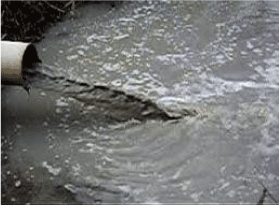
Figure 6. A typical dark color of tannery effluent that are discharged into aquatic system
Coming back to the initial paragraphs of this manuscript, the amount of potable water needed for a 7.5 billion people world, there is only one solution: to take care about any type of wastewater discharges, once they probably will go through to the rivers and after to the sea, flowing with hundreds of chemicals, including pharmaceuticals, dyes, surfactants, organic and inorganic compounds. Of course that at previous step, we have to use less natural resources and manage them in an intelligent way. It should be kept in mind that each person is responsible by a better environment and we have to ask us what to do with our left pharmaceuticals? Why not reuse the water used during bath and laundry? Why should we try to understand environmental regulations? Again, by the few examples and numbers here presented we may believe and prevent the damage that pollutants represent to animals and human health.
- Adeel M, Song X, Wang Y, Francis D, Yang Y (2017) Environmental impact of estrogens on human, animal and plant life: A critical review. Environ Int 99: 107-119. [Crossref]
- Chandra R, Bharagava RN, Kapley A, Purohit HJ (2011) Bacterial diversity, organic pollutants and their metabolites in two aeration lagoons of common effluent treatment plant (CETP) during the degradation and detoxification of tannery wastewater. Bioresour Technol 102: 2333-2341. [Crossref]
- Rudd MA, Ankley GT, Boxall AB, Brooks BW (2014) International scientists research priorities for pharmaceuticals and personal care products in the environment. Integr Environ Assess Manag 10: 576-587. [Crossref]
- Tigini V, Giansanti P, Mangiavillano A, Pannocchia A, Varese GC (2011) Evaluation of toxicity, genotoxicity and environmental risk of simulated textile and tannery wastewaters with a battery of biotests. Ecotoxicology and Environmental Safety 74: 866-873. [Crossref]
- United Nations Organizations (2018) A ONU e a populacao mundial.
- Instituto Brasileiro de Geografia e Estatistica - IBGE (2018) Projecao da populacao do Brasil e das Unidades da Federacao.
- Food and Agriculture Organization of the United Nations - FAO (2018) Water Uses.
- Xie, YT (2004) The capital of leather industry - Town of Shuitou, in Pingyang County, Zhejiang Province,one of the nine major severe encironmental pollution cases in Zhejiang Province. China News Media Center.
- Yadav A, Misha S, Kaithwas G, Raj A, Bharagava RN (2016) Organic Pollutants and Pathogenic Bacteria in Tannery Wastewater and their Removal Strategies. In: Microbes and Environmental Management
- Tarantola A (2014) How leather is slowly killing the people and places that makes it?
- Shukla OP, Rai UN, Dubey S (2009) Involvement and interaction of microbial communities in the transformation and stabilization of chromium during the composting of tannery effluent treated biomass of Vallisneria spiralis L. Bioresour Technol 100: 2198-2203. [Crossref]
- Akhtar MF, Ashraf M, Javeed A, Anjum AA (2018) Association of textile industry effluent with mutagenicity and its toxic health implications upon acute and sub-chronic exposure. Environ Monit Assess 190: 179. [Crossref]
- Saxena G, Bharagava RN (2015) Persistent organic pollutants and bacterial communities present during the treatment of tannery waste water. In: Chandra R (ed) Environmental waste management. CRC Press, Taylor and Francis Group, Boca Raton, FL, 217-247.
- Buljan J, Sahasranaman A, Hannak J (1999) Regional Programme Office (RePO - UNIDO) Regional Programme for Pollution Control in the Tanning Industry in South East Asia. Occupational safety and health aspects of leather manufacture. Guidelines and recommendations for managers and supervisors of tanneries and effluent treatment plants.
- DeLeo PC, Ciarlo M, Pacelli C, Greggs W, Williams ES, et al. (2018) Cleaning Product Ingredient Safety: What Is the Current State of Availability of Information Regarding Ingredients in Products and Their Function? ACS Sustainable Chem. Eng 6: 2094-2102.
- Rebello S, Asok AJ, Mundayoor S, Jisha MS (2014) Surfactants: toxicity, remediation and green surfactants. Environ Chem Lett 12: 275-287.
- Yuan CL, Xu ZZ, Fan MX, Liu HY, Xie YH, et al. (2014) Study on characteristics and harm of surfactants. Journal of Chemical and Pharmaceutical Research 6: 2233-2237.
- Kant R (2012) Textile dyeing industry and environmental hazard. Natural Science 4: 22-26.
- Zhang W, Liu W, Zhang J, Zhao H, Zhang Y, et al. (2012) Characterization of acute toxicity, genotoxicity and oxidative stress posed by textile effluent on zebrafish. Journal of Environmental Sciences 24: 2019- 2027. [Crossref]
- Sharma KP, Sharma S, Sharma S, Singh PK, Kumar S, et al. (2007) A comparative study on characterization of textile wastewaters (untreated and treated) toxicity by chemical and biological tests. Chemosphere 69: 48-54. [Crossref]
- Meireles G, Daam MA, Sanches ALM, Zanoni MVB, Soares AMVM, et al. (2018) Red disperse dyes (DR 60, DR 73 and DR 78) at environmentally realistic concentrations impact biochemical profile of early life stages of zebrafish (Danio rerio). Chem Biol Interact 292: 94-100. [Crossref]
- Vacchi F, Vendemiatti JAS, Silva BF, Zanoni MVB, Umbuzeiro GA (2017) Quantifying the contribution of dyes to the mutagenicity of waters under the influence of textile activities. Science of the Total Environment 601-602: 230-236. [Crossref]
- Borrely SI, Morais AV, Rosa JM, Badaro-Pedroso C, Pereira MC, et al. (2016) Decoloration and detoxification of effluents by ionizing radiation. Radiation Physics and Chemistry 124: 198-202.
- Suryavathi V, Sharma S, Sharma, Shweta, Saxena P, et al. (2005) Acute toxicity of textile dye wastewaters (untreated and treated) of Sanganer on male reproductive systems of albino rats and mice. Reproductive Toxicology 19: 547-556. [Crossref]
- Varano V, Fabbri E, Pasteris A (2017) Assessing the environmental hazard of individual and combined pharmaceuticals: acute and chronic toxicity of fluoxetine and propranolol in the crustacean Daphnia magna. Ecotoxicology 26: 711-728. [Crossref]
- Fent K, Weston AA, Caminada D (2006) Ecotoxicology of human pharmaceuticals. Aquat Toxicol 76: 122-159. [Crossref]
- Glassmeyer ST, Kolpin DW, Furlong ET, Focazio MJ (2008) Environmental presence and persistence of pharmaceuticals: an overview. In: Aga DS (ed) Fate of Pharmaceuticals in the Environment and in Water Treatment Systems. Taylor & Francis, Boca Raton, FL.
- Calamari D, Zuccato E, Castiglioni S, Bagnati R, Fanelli R (2003) Strategic survey of therapeutic drugs in the rivers Po and Lambro in northern Italy. Environ Sci Technol 37: 1241-1248.
- Santos LH, Araujo AN, Fachini A, Pena A, Delerue-Matos C, et al. (2010) Ecotoxicological aspects related to the presence of pharmaceuticals in the aquatic environment. J Hazard Mater 175: 45-95. [Crossref]
- Fabbri E, Franzellitti S (2016) Human pharmaceuticals in the marine environment: Focus on exposure and biological effects in animal species. Environ Toxicol Chem 35: 799-812. [Crossref]
- Brooks BW, Foran CM, Richards SM, Weston J, Turner PK, et al. (2003) Aquatic ecotoxicology of fluoxetine. Toxicol Lett 142: 169-183. [Crossref]
- Barata C, Baird DJ, Nogueira AJ, Soares AM, Riva MC (2006) Toxicity of binary mixtures of metals and pyrethroid insecticides to daphnia magna Straus. Implications for multi-substance risks assessment. Aquat Toxicol 78: 1-14. [Crossref]
- Agencia Nacional de Vigilancia Sanitaria | Anvisa (2018) Anuario Estatistico do Mercado Farmaceutico 2017.
- Rand GM, Wells PG, Maccarty LS (1995) Introduction to aquatic toxicology: fundamentals of aquatic toxicology: effects, environmental fate and risk assessment. Washington, DC: Taylor e Francis.
- Associacao Brasileira de Normas Tecnicas (2016) Ecotoxicologia aquatica - Toxicidade Aguda- Metodo de ensaio com Daphnia spp (Crustacea, Cladocera). ABNT NBR 12713, Rio de Janeiro.
- Associacao Brasileira de Normas Tecnicas (2012) Ecotoxicologia aquatica - Determinacao do efeito inibitorio de amostras de agua sobre a emissao de luz de Vibrio fischeri. ABNT NBR 15411, Rio de Janeiro.
- Silva VHO, Batista APS, Teixeira ACSC, Borrely SI (2016) Degradation and acute toxicity removal of the antidepressant Fluoxetine (Prozac) in aqueous systems by electron beam irradiation. Environmental Science and Pollution Research 23: 11927-11936. [Crossref]
- Lechuga M, Fernandez-Serrano M, Jurado E, Nunez-Olea J, Rios F (2016) Acute toxicity of anionic and non-ionic surfactants to aquatic organisms. Ecotoxicol Environ Saf 125: 1-8. [Crossref]
- Fernandez-Serrano M, Jurado E, Fernandez-Arteaga A, Rios F, Lechuga M (2014) Ecotoxicological assessment of mixtures of ether carboxylic derivative and amine oxide based nonionic surfactants on the aquatic environment. Journal of Surfactants and Detergents 17: 1161-1168.
- Tominaga FK, Batista AP, Teixeira ACSC, Borrely SI (2018) Degradation of diclofenac by electron beam irradiation: Toxicity removal, by-products identification and effect of another pharmaceutical compound. Journal of Environmental Chemical Engineering 6: 4605-4611.
- Liang J, Ning X-an, Sun J, Song J, Lu J, et al. (2018) Toxicity evaluation of textile dyeing effluent and its possible relationship with chemical oxygen demand. Ecotoxicology and Environmental Safety 166: 56-62.
- Blacksmith Institute (2016) The world’s worst 2013: the top ten toxic threats.
- IPPC (2013) Best Available Techniques (BAT) for the tanning of hides and skins. Industrial emissions directive (2010/75/eu) integrated pollution prevention and control (ippc). a reference document by european commission joint research centre (EUJRC). Publications Office of the European Union, Luxembourg.
- Monitor (2009) Uganda: leather factory faces closure over pollution.






